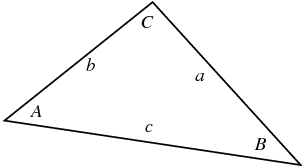Can the measures 7, 11, and 15 be side lengths of a triangle? If so, is the triangle acute, obtuse, or right?
1 Answer
Yes, and the triangle is obtuse.
Explanation:
As no side of the triangle would be greater in length than the sum of the remaining two sides, it is possible to have those values as the side lengths of a triangle. Now let's look at the angles.
The law of cosines states that

In the triangle considered, we have
We can now use the law of cosines to solve for the angles. If we only care about whether the triangle is obtuse, right, or acute, we can look at the angle opposite the longest side, as it will be the greatest angle.
As
.
.
.
While the above is enough to answer the question, if we wished to solve for all of the angles, we would proceed in the following manner:
Finally, we know
Then we get

